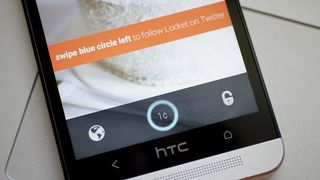One week with Locket, the lockscreen app that pays to show you ads [Updated]

Upate: Locket no longer pays users for ads. Instead, the company is saying that it is just pushing out relevantly curated content to users on their lockscreen to add value. You can read more about the changes on Locket's blog.
Original story: Swipe in, cash out. That's in Locket's description on Google Play, and it pretty much sums up the idea behind the lockscreen app. In a nutshell, you install it on your phone and see an advertisement every time you wake your phone. In exchange, you get paid a little. Very little.
Sounds horrible, doesn't it? Who wants to see adverts every time you turn on your phone? Thing is, Locket's done a pretty good job here. We've been using it for a week now, and it's time to share a few findings. Maybe we're doing so from the comfort of a newly purchased yacht. Or maybe we've managed to scrounge up a little extra beer money.
Read on to find out.
How it works ...














I get advertisements. Between this job and my previous career, I get that they're a necessary evil. But Locket sounds like a good deal, right? You've got to unlock your phone anyway — might as well make a couple bucks at it. You're essentially renting out some of the most prime real estate on your phone.
And Locket, as an app, works pretty darn well. Ads are shown full screen and with high-resolution images — none of those janky banners that plague far too many ad-supported Android apps. They're attractive — and don't underestimate the importance of a nicely designed ad. Anything less than what Locket's showing now, and we wouldn't even be having this discussion. Locket's got the design down nicely.
Be an expert in 5 minutes
Get the latest news from Android Central, your trusted companion in the world of Android
That's form. As far as function is concerned, you need to install Locket and disable whatever you're currently using — most likely whatever was on your phone by default — and you should be good to go. (We had a couple days where Locket didn't seem to take over as our default lockscreen, but an app update seems to have worked that out.) You'll then see a full-screen ad whenever you go to unlock your phone.
From here you have two choices — unlock the phone by swiping to the right, or swipe left to "interact" with the ad. That means as little as opening up a web page, or as much as watching a YouTube video.

This is where you can run up against a little bit of Android wonk. If, say, "interacting" with the ad means watching a YouTube video, you might run into that "Complete action using …" dialog box if you don't have a default set. Not exactly a great user experience, but that's not Locket's fault.
Otherwise, it's quick and easy.
Show me the money … or not

So, how much are you going to get paid with Locket? The truth is, not much. This is a long-term play, at best, and even then you're not going to be buying much more than a six-pack with your spoils. You get the impression using Locket that you get 1 cent per unlock. But the truth — and this isn't anywhere in the fine print that we've seen, only in other published reports — is that it's capped at 3 cents per hour. Any unlocks beyond that — and the ads you view — are money in someone else's pocket. Not yours. (At the time of this writing, Locket hasn't responded to an e-mail seeking confirmation and clarification on the 3-cents-per-hour cap.)
Doing the math, that's a max of 72 cents a day. Or $5.04 a week. Or $262.80 a year — if you're unlocking your phone three times and hour, 24 hours a day. Which you won't be doing.
There are opportunities for bonuses. Locket says it'll "identify loyal Locket users and sometimes give out bonuses randomly." And you can earn extra money for referrals — $1 for each friend who signs up. Though there's a cap on this, too. Locket smartly says you can invite as many folks as you want, but it stops paying after $5 per account per month. This time, that's in the fine print.
Want to cash out? Cool. But you'll have to wait until you amass $10, and then you can either "cash out" through Paypal, or get a gift card or donate to charity.
The bottom line ...
My haul, after a week's use? A whopping $1.72. Let's round that up to $2 even, though, for those two days in which the app wasn't working as it should. That still only puts me one-fifth of the way toward actually putting any money in my pocket — basically another month of use. And, no, I'm not about to spam my friends for referrals.
Locket correctly sees that there's money to be made from your lock screen — that prime piece of real estate that you look out dozens of times a day. But just look at the numbers. Now ask yourself if losing the functionality of most every other lockscreen out there is worth 72 cents a day — max. No more quick-launch apps. No more notifications or widgets. You get some attractive advertising, sure. And Locket is nicely done. Make no mistake about that.
But for me, the money's just not there.
